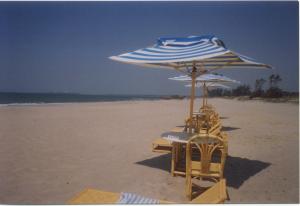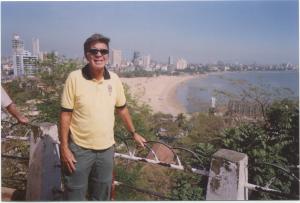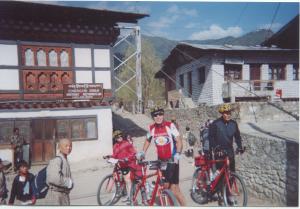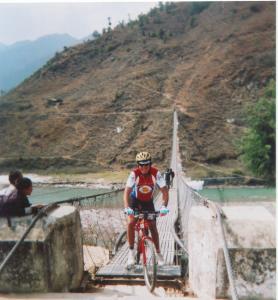The Opportunity
My prior trip to India in 1997 was highly enjoyable, I promised myself I would return. The opportunity to participate in two successive bike tours (India and Bhutan) presented itself this past February and March. These tours were operated by two leading travel companies, Butterfield and Robinson (B&R) of Toronto (Rajistan biking) and Backroads of Berkeley, California (Bhutan Mountain Biking and Hiking).
Preparations
I arranged air transportation (New York to Mumbai/Delhi via Bangkok) via Thai Airways, I was eagerly awaiting this adventure. However, around Thanksgiving, the telephone rang and the caller ID indicated that B&R was calling from Toronto. I knew it was bad news. They cancelled the trip because a number of the enrollees had either dropped out or switched to another date.
I could have easily changed my Thai tickets to skip India and simply go to Bhutan via Bangkok with a small penalty, but I very much wanted to return to India. I recalled my prior memorable rail journey in Rajastan and Agra (site of the Taj Mahal). Within two hours I found another “luxury” train tour, the Deccan Odyssey” for the same period as the cancelled bike tour. This tour runs between Mumbai (formerly Bombay) and Goa along the Arabian Sea and the inland hinterlands. Although this train is opulent, it cost about half as much as the B&R bike tour.
Change of Plans – The Train
The nine-day tour package included seven nights on the train, two nights at a Mumbai hotel, meals, airport transfers, sightseeing and touring programs at all the daily train stops.
Although the train’s capacity was over 80 passengers, our week had only 25 to 30. Each rail car had four bedrooms, each with private facilities ensuite. There were also two restaurant cars, a bar car, a library car, a gym, conference and internet car. There were only three passengers in my car served by one full time cabin attendant. I truly felt like a tycoon or maharaja in my (semi)-private railroad car!
The passengers were from all world regions, except Latin America. About fifteen of them were married women travelling with a friend or relative, without their spouses. Just as my wife, Joan, opted not to join me on this trip, their husbands made the same decision. In retrospect, I think these spouses made a big mistake. The tour turned out to be a highly enjoyable experience and entailed absolutely no problems or hardships with health, food, insects, air conditioning, plumbing or security.
The cuisine on the train was excellent. In addition to a daily changing six-course Indian tasting menu, there was always a continental cuisine option. I was fortunate to be dining with a woman native to Mumbai, Kirann, who had moved to Maryland and her friend, Lynn. Kirann, of course, was knowledgeable about Indian foods. I gained insights about local customs and issues through her. At the Mumbai station, I was introduced to her mom who still resides there.

 Typical Arabian Sea Beach
Typical Arabian Sea Beach
By no means were we “cooped up” on the train. In fact, we were off the train for six or seven hours daily, at one or more of its stops. At each station, we were greeted by local entertainers and musicians. We were given a flower garland and a traditional welcoming colored paste spot on our foreheads. An air conditioned comfortable bus took us to the historical, natural, cultural or religious attractions of the town. At three places, including Goa, we spent three or four restful midday hours at splendid (mostly deserted) beach resorts, swimming in the Arabian Sea, or at an adjacent pool. We had lunch at the resort’s restaurant, or the train’s kitchen crew catered lunch on the beach. They even brought the train’s china and cutlery down to the beach for this lunch service!
Aside from Goa, the other cities in mesmerizing Maharatra state are unknown to most Americans – Ganapatipule, Rafnagiri, Sudhudurg, Tarkarli, Sawantwadi, Pune, Auragabad and Nashik. At each, we had a knowledgeable local guide.
Especially memorable was a visit to the World Heritage Site, the Ellora Caves. Within the caves are 34 brilliantly carved rock-cut temples representing Buddhist, Jain and Hindu faiths.
I spent the few daylight hours we had on the train, peering out at the magnificent countryside, landscapes and towns along the rail right-of-way from the large picture windows of my cabin, or one of the lounges, or a restaurant car.
Advantages
The major advantages of such a train journey are the following. 1) The food preparation was controlled and met high cleanliness standards. As a result, there were no cases of “Delhi-belly” among the passengers. I didn’t need to take any of the pills my doctor had prescribed. 2) We avoided long bus or car drives on substandard roads. 3) There were no worries about directions, where to eat, missing a major tourist attraction or security and safety issues. 4) Of course, I only had to pack and unpack once during this week.
India Undergoes Changes
India does still have a major poverty issue. Eighty percent of the population lives on $2.00 or less daily. We saw numerous slum areas, people living in fragments of tents. There were beggars and hawkers, some fairly aggressive. However, I noticed that the situation has improved markedly since my previous visit. No one seemed to be hungry. The air pollution in the cities has also improved. There is evidence of a rapidly growing hep, upwardly mobile well-dressed middle class. They carry cell phones and frequently check the latest stock prices on screens in restaurants, stations and airports.
At two “sensitive” towns, we were accompanied by two friendly uniformed soldiers or tourist policemen, but there were no incidents.
Unlike my previous trip to India, I encountered absolutely no bureaucratic problems. My entry into the country at Mumbai airport including obtaining my luggage, immigration formalities and locating my waiting guide and driver, took less than ten minutes – far better than on my return to JFK Airport in New York!

 Atop Malabar Hill Overlooking Mumbai
Atop Malabar Hill Overlooking Mumbai
The Taj Mahal Palace Hotel
The two nights in Mumbai were spent at its best hotel, the Taj Mahal Palace, My room on the tenth floor, overlooked the harbor and the striking 1911 “Gateway of India” arch, Marine Drive and Chowpatty Beach. The city sightseeing program included a stop at Gandhi’s home (now a museum), checking out the panorama of the city and beach from atop Malabar Hill and visits to various religious sites and other museums.
The Imperial Hotel in New Delhi
Then I flew to Delhi. Imagine a super-luxury (Delhi’s best) hotel in New York at 42nd Street and Broadway, set in a lushly-landscaped eight acres of gardens with a large outdoor swimming pool. This is what my hotel, the Imperial was in Delhi, a city larger than New York. I have spent over 2,000 nights in hotels, but I cannot think of one that was better. The entry drive, garden and pool areas were lined by rows of mammoth palm trees. Within five minutes of strolling out of the hotel’s grounds, I was amidst the hubbub and tumult of this vibrant metropolis.
The hotel has about seven outstanding restaurants with varied Indian and continental cuisines. I enjoyed meals at several of the hotel’s outdoor terrace restaurants, which overlooked the pool or gardens under a full moon. I didn’t have a problem with the spicy fare. If the menu choice was highly spiced (indicated with a pepper icon), I simply requested it “moderately spiced”. I spent three days in Delhi, looking at the national government buildings, etc., relaxing by the pool after the tiring previous week, reading a couple of books about India.
This hotel (and the Taj in Mumbai) would cost about the same as one of New York’s top hotels (for rooms and meals). India currently has a shortage of hotel rooms which has created upward pressure on the rates. In India for items that locals purchase, the prices are substantially lower than in the U.S. For example, a McDonald’s “Happy Meal” costs about 40 cents. Incidentally, there are no beef items on the McDonald’s menu.
In Canada and Europe, we usually stay in three-star or even two-star hotels. However, in a country such as India, due to health, safety and security considerations, I think it is prudent to patronize better hotels and restaurants. By the way, I had my shots updated before I left, I needed a hepatitis inoculation. In addition, I brought a weekly malaria pill. I had taken the same pill on previous trips to third-world countries without a problem. On this trip, though, I noticed hardly any mosquitos.
When To Go
The winter months are definitely the best for visiting this region. There wasn’t a drop of rain while I was India. In Delhi, it got up to about 70 each day, while in Mumbai and Goa, which are further south, the highs were in the eighties.
I then flew from Delhi to Bangkok on Thai Airways to meet my Backroads group and leader in Bangkok for the flight to Bhutan. Although several articles mentioned that there were problems with the brand new giant ultramodern airport in Bangkok right after its opening in Fall of 2006, I didn’t encounter any. The airport was unlike any I’ve seen in my travels to 70 countries. The seven-level terminal claims to be the world’s first or second largest, appears to be the most technologically advanced. It has the tallest control tower. Almost 100 airlines have used the airport. (During the shakedown period in Autumn, 2006, several of the short haul lines returned to the old airport.) Within the terminal building, there is a dazzling array of shops and restaurants, comparable to any downtown or suburban mall I have seen. I had no trouble finding important medications for my contact lens which I needed and definitely wouldn’t have found anywhere else.
The Novotel – at the airport
Since I had already been to Bangkok several times, I decided to stay at the new Novotel at the airport, the 512-room ultramodern hotel is within a ten-minute walk or five-minute shuttle from the terminal. This sizeable atrium hotel is an attraction in itself! Everything is state-of-the-art, yet user friendly. For example, the “Do Not Disturb” and “Please Clean This Room” signs were replaced by easy-to-use electronic switches. The room’s temperature and lighting control switches were on one bedside console. The daily rate for this hotel is under $200.00 and it also had a much lower four-hour rate for travelers who are changing planes.
There is a lush outdoor garden and pool with a snack bar and a large fitness center and spa. The massage didn’t “do anything for me", though. On the other hand, the cuisine was extraordinary. My theory is that every chef in the world should have to spend part of his apprenticeship in Thailand. Cooking is taken to the next level, this French hotel marries French and Thai culinary techniques. The nightly buffet dinner consisting of various small plates of delectable Thai and continental specialties cost about $40.00, including service and two glasses of wine.
To Paro Bhutan
The four-hour flight from Bangkok to Paro Bhutan was arranged by Backroads (with a stop in Bangladesh). It was on one of Drukair-Royal Bhutan Airline’s two modern Airbuses, we enjoyed magnificent views of snow-capped Himilaya mountains en route. This landlocked and isolated nation was to be the 49th country in which I have cycled.

 Getting Ready to Ride
Getting Ready to Ride
Biking – or is it mountain climbing?
On arrival at our hotel, we checked and adjusted our Cannondale mountain bikes provided by Backroads. We were introduced to Namgay, our local guide, and his support staff of three. We cycled nineteen miles to a monastic fortress, built to celebrate a seventeenth century military victory over neighboring Tibet. The sky was clear enough for us to glimpse the 20,000 feet peak of Jomolhari.
We mountain hiked the next couple of days. Daily climbs were of 1,500 feet, some sections were steep and harrowing. The trails were not marked, but the experienced guides never got lost. The elevations were often on rocks covered by a slippery coating of gravel. The hiking and biking destinations were cliffside temples, monasteries and dzongs, spiritual and communal centers. We had to wear collared shirts, long pants and remove our shoes before entering the sites.
Since we were based in three towns for this eight-day tour, we were shuttled in a comfortable minibus between hotel bases. These minibus transfers took a total of over 10 hours during the whole tour. The bikes were carried in a separate truck. There is basically only one road that runs across the country (about the size of Switzerland). The road was one lane wide, with oncoming traffic, one of the vehicles had to go off to one side to pass, it frequently ran along a dropping cliff, hardly ever guarded by a railing – definitely gave me a “precarious” feeling!

 Author Crosses Bhutan Bridge
Author Crosses Bhutan Bridge
After leaving the capital city of Thimpu, we walked through a nearby valley’s rice paddies and forests. We were invited to visit a centuries-old farmhouse. We crossed the major river a number of times on rope, suspension or cantilevered bridges. The bridges were wide enough for pedestrians or cyclists, only a few could accommodate cars. Most Bhutanese (whose annual income might be $3,000 or so) don’t own cars.
I noticed hardly any bicycles, unusual for an Asian country. We didn’t have any problem with cars or trucks. If one came in the opposite direction, we moved onto a shoulder (when there was one). Several times a big truck stopped to let us go by. We often passed “road construction sites” where men and women (some with babies on their backs) were chopping rocks by hand for a new roadbed. These stops, delays and photo-ops, of course, made the going slow. We cycled no more than 25-30 miles on any one day.
We stopped at least once every day at a religious site, sometimes more. We may have spent more time at these sites than on the road, on our bikes. Backroads (sometimes known as “Snackroads”) provided picnic or restaurant lunches along the way. The support from the guides and staff was excellent.
The road up to the third hotel was fairly steep and moderately long – known as the Himalaya “foothills”. We were usually at altitudes between 7,000 and 10,000 feet. I didn’t have problems as such, the altitude probably contributed, though, to our overall fatigue, plus jet lag. Along the routes, we passed famers and road construction workers. Most spoke a few words of English and were fairly friendly. We saw cows, horses, even yaks!
Bhutan does not have trains, traffic lights, disposable cameras and contact lens. I don’t know if smoking or usage of plastic bags are illegal, but their use is certainly discouraged. We didn’t encounter beggars or evidence of hunger, but there were also few signs of affluence. There were many dogs – in one place their nocturnal barking kept us awake, none of them ran after us. I will always remember Bhutan for its large numbers of colored and white prayer flags strategically placed all over the country
Bhutan’s king decreed that “gross national happiness” is a more important goal than “gross national product”. I and my group members were most happy during our brief stay there!
More Information
Cheap Hotels
The Luxury Trains
Backroads